It is reported that the National Ministry of Science and Technology recently announced the second batch of 10 cities and 10 million LED lighting pilot project demonstration cities, approved the agreement in Beijing, Linyi, Changzhou, Huzhou and other cities to carry out semiconductor lighting application engineering pilot work, which It is a phased achievement that our city has obtained since it applied for the creation of a pilot city of “Ten Cities in Ten Thousand Cities†since 2009. The relevant person in charge of the Municipal Bureau of Science and Technology stated that by 2015, the city’s LED lights will be used to reach 600,000 baht, including 10,000 for street lights for outdoor use, 300,000 for indoor applications, and 290,000 for landscape lights.
Hucheng LED light application has exceeded 120,000 yuan
“I remember that when I went home at night, the street lights on both sides of the road were dark, and some of them were still flashing. Not only were the lighting effects bad, but they also affected my mood.†Wang Qin, who is engaged in training school education, went to work and commuted through Xinhua. Lu, “The lights on this road were later replaced by LED lights. The way home was bright and I was in a good mood.â€
In recent years, according to the characteristics of semiconductor LED lighting and the city's urban lighting master plan, highlighting the lakeside, ecological, modern landscape garden city of Huzhou to integrate LED lighting "clear and beautiful highlights", combined with energy saving, environmental protection and ecological principles, the city has further implemented the lighting, Lighting project. Since this year, the government has invested in newly-built or rebuilt road lighting, landscape lighting and other public facilities (including government offices, libraries, museums, gymnasiums and other places) lighting application projects using LED products.
It is understood that at present, Bronze Road, Hongfeng Road, Xinhua Road, etc. in the downtown area, Erhuan West Road, Fenghuang Road, Jiqiang Road in Huzhou Development Zone, Jingliu Road, Jingwu Road, and 318 National Highway in Huxing District (Huzhou Section) ), Xuefu Road, Bachelor Road, Customs Road Section, Nanxun District Government Building, etc. have already promoted the use of LED street lamps. The total number of LED lighting applications in the city's landscape lights has reached more than 120,000. In addition, the LED is also used in tunnels. At present, the Qingshanling tunnel on the 104 national highway has applied 400 watts of power LED lamps.
At the end of February this year, the state launched a major deployment of the "Ten Thousand Cities and Ten Thousand Ones." Subsequently, the city's national "Ten Thousands Million" semiconductor lighting application engineering pilot construction work leading group quickly went to the province's first pilot cities - Ningbo City, Hangzhou City, study and research. Based on their advanced experience, in light of the actual situation in Huzhou, the “Hangzhou City Ten Thousand Cities and Ten Thousands†Semiconductor Lighting Application Project was formulated.
The person in charge of the Municipal Science and Technology Bureau stated that this year, the city has invested 10 million yuan in more than 10 LED-related investment projects, and the planned total investment has reached 830 million yuan. During the “Twelfth Five-Year Plan†period, there are five LED-related investment projects with a total investment of over RMB 100 million. The total investment of the project is RMB 2.54 billion. After the implementation of the project, the sales income will reach RMB 4.53 billion.
It can be imagined that the city has officially entered the pilot city of the “Ten Cities and Ten Thousand Cities†pilot project, which will promote the rapid transformation of traditional lighting companies and will greatly benefit the cultivation of a number of key semiconductor lighting application companies with strong competitiveness. At present, there are more than 30 energy-saving electric light source manufacturing enterprises in the city, and the output value has reached 1.5 billion yuan. Zhejiang Jingri Lighting Technology Co., Ltd., Zhejiang Qiushi Information Electronics Co., Ltd., and Huzhou Haizheng Electronic Technology Co., Ltd. have been produced. , Zhejiang Saite Lighting Electric Co., Ltd. and other LED-related production of key enterprises.
At the same time, Huzhou LED related industries have developed well and have 3 key high-tech enterprises supported by the state. Among them, “Jilin Lighting†and “Seeking Information Electronic†have become the National Development and Reform Commission, the Ministry of Housing and Urban-Rural Development, and the Ministry of Transport Semiconductor lighting product application demonstration project product bid unit.
In the next four years, 600,000 LED lights will be installed in Wuhu Prefecture.
"LED lighting has a significant increase in luminous efficiency and lifespan compared to traditional light sources, and it has many advantages such as power saving, energy saving, environmental protection, etc. Therefore, the promotion and application of LED lighting fixtures is a resource-saving and environment-friendly type. The society and accelerating the development of LED-related industries all have positive significance. The relevant person in charge of the Municipal Science and Technology Bureau stated that becoming a pilot city of the “Ten Cities and Ten Thousand Cities†will be an advantageous opportunity for accelerating the promotion and application of LED lamps in the city. It is understood that by 2015, the city's promotion and application of LED lights will reach 600,000, including 10,000 outdoor lighting applications, 300,000 indoor applications, landscape lighting applications 290,000. “With the promotion and application of more than 120,000 LED landscape lights and street lights in the center of the city, we will be involved in the renovation of urban street lights, new residential construction projects, underground tunnel lighting projects, new large shopping malls, and hotel lighting projects. The project will continue to promote the use of LED lighting fixtures.†The relevant person in charge of the Municipal Science and Technology Bureau introduced. This means that, four years later, the city will truly usher in the era of LED lighting products entering the city and entering the lives of ordinary people.
It is understood that the city's promotion and application of LED lights to the center of urban areas, development zones as a core demonstration area, in accordance with the "high starting point, high standards" requirements in all areas of the city in full swing. “From the current situation of the promotion and application of LED lights in our city, the demonstration effect of the central city has been clearly demonstrated. The application of street lights and landscape lights has exceeded 120,000 won. The counties and districts are gradually developing, but compared with the central city, The gap is still relatively large." The person in charge of the Municipal Science and Technology Bureau said.
According to the city's LED application demonstration 2015 target distribution plan, in the next four years, the total number of applications in Changxing County, Deqing County, and Nanxun District will reach 10,800, respectively. Anji County, Wuxing District, Huzhou Development Zone, and Taihu Resort Area will reach 7.1, 5.1 respectively. 6.1, 23,600 yen. “In order to better promote the construction of LED demonstration pilot cities in our city, all counties and districts and relevant departments must make clear the current status of implementation of LED applications in each region. At the same time, compare the implementation of the LED demonstration application project's overall goals, find out the gaps, and do It is a good job for the next step," said the person in charge of the Municipal Science and Technology Bureau.
Energy-saving, eco-friendly LED lights have a lot of benefits
By 2015, the city can not only achieve the goal of 600,000 LED lights to light Huzhou, but also can save 35 million kWh annually, reduce CO2 emissions by 35,000 tons, SO2 emissions by 1,000 tons, and save 15,000 tons of coal. "The development, manufacture, application, promotion and popularization of LED not only improved the quality of the city, improved the quality of life of citizens, but also promoted the construction of a resource-saving and environment-friendly society, and achieved stable, rapid and sustainable economic development. The person in charge of the Municipal Science and Technology Bureau said.
Industry analysis, compared with ordinary fluorescent lamps, LED lamps with high luminous efficiency, low power consumption, long life, easy control, maintenance-free, safe and environmentally friendly advantages. In terms of luminous efficiency, LED lamps will be twice as high as ordinary fluorescent lamps. In layman's terms, luminous efficiency refers to the ability of a luminaire to convert energy absorbed during excitation into light energy. Since a light bulb is a device that converts electrical energy into light energy, if the voltage and power are not used, its use efficiency will be compromised. It is understood that, at present, the luminous efficiency of fluorescent lamps is about 55 to 80 lm/W, while the luminous efficiency of LEDs is above 100 lm/W, and some luminous efficiencies have reached 130 lm/W, and will continue to increase in the future.
In terms of lamp efficiency, ordinary fluorescent lamps are 360-degree luminous, and light emitted in the opposite direction is of no use. In general, lighting efficiency is only about 70%. LED fluorescent light is 120 degrees, all effective light. In terms of power consumption, LED lamps can save about half of the electricity compared with ordinary fluorescent lamps. That is, using an 18-watt LED fluorescent lamp can replace a 36-watt fluorescent lamp. In terms of service life, the lifetime of an LED fluorescent lamp can reach 50,000 hours, while the lifetime of a good ordinary lamp is usually only 5,000 hours, which is a difference of nearly 10 times.
The responsible person of the Municipal Bureau of Science and Technology said: “Through the opportunity of pilot city construction in Ten Cities and Ten Thousand Cities, we will encourage the use or transformation of large-scale buildings supporting long-term lighting, high-power industrial enterprises and new shopping malls. "At the same time, for large-scale buildings such as new shopping malls that are contracted by non-government organizations, if indoor lighting uses LED lamps and is listed as a LED application demonstration project, a certain financial subsidy will be given.
It is understood that a number of enterprises in our city have planned to invest more than 100 million yuan to support the development of the LED industry. "The LED lighting industry is an energy-saving, emission-reducing, environmental-friendly, safe and sustainable industry. To invest in this project, it is not only possible to realize economic benefits, but also to achieve social benefits," said the person in charge of the City Economic and Information Commission.
Rigid Flex PCB , combine the best of both Rigid PCB and flex circuits board into one unit
We are manufacturing reliable Flex and Rigid-Flex boards using most advanced process. Rigid-flex PCBs improve reliability and lower costs associated with your device.
In order to let you have a deeper understanding of rigid Flexible PCB so as to select more suitable PCB products for your products, this article will give you a detailed understanding of the definition, type, application, manufacturing process, advantages, materials used in manufacturing, and stack up structure of rigid flexible PCB. And design guidelines
In electronics, we sometimes encounter seemingly new technologies that have roots in the past. Rigid Flex PCB technologies trace back approximately 50 years to the need to replace wiring harnesses in spacecraft. The first commercially available mobile computer (which weighed a little over 25 pounds!) used rigid flex technologies.
Rigid Flex PCB is an excellent combination of rigid boards and Flexible Circuits . Flex Rigid PCB is connected by PTH (plated through holes). Higher component density and better quality control can be guaranteed.
Today, laptop computers, wearable technologies, medical devices, test equipment, and satellites are a few of the applications that rely on rigid flex PCBs.
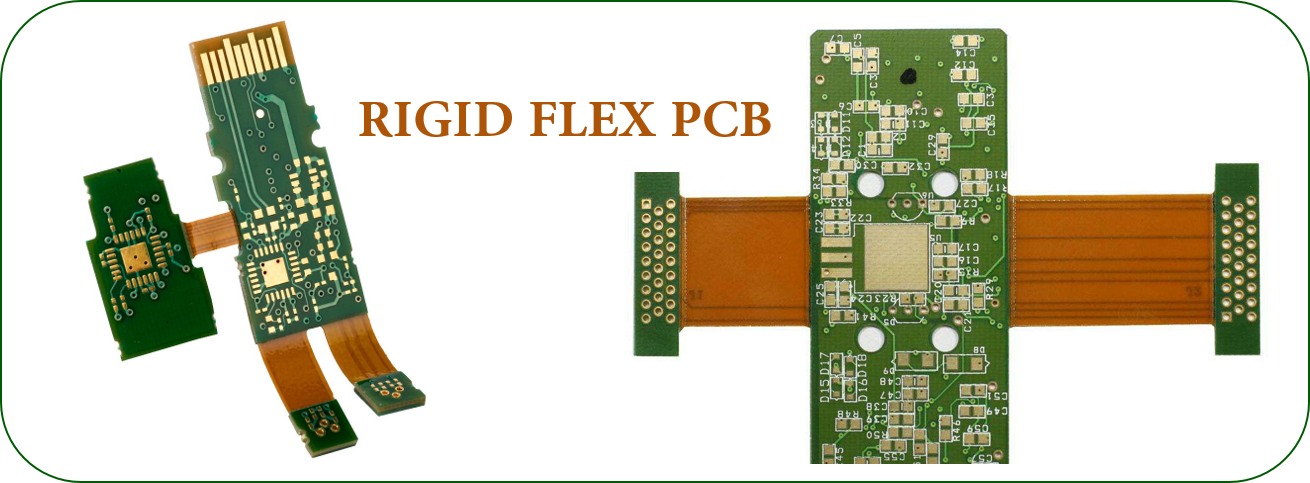
WHAT IS RIGID FLEX PCB?
Rigid Flex Printed Circuit Boards are boards using a combination of flexible and rigid board technologies in an application. Most rigid flex boards consist of multiple layers of flexible circuit substrates attached to one or more rigid boards externally and/or internally, depending upon the design of the application. The flexible substrates are designed to be in a constant state of flex and are usually formed into the flexed curve during manufacturing or installation.
Rigid Flex designs are more challenging than the design of a typical rigid board environment, as these boards are designed in a 3D space, which also offers greater spatial efficiency. By being able to design in three dimensions rigid flex designers can twist, fold and roll the flexible board substrates to achieve their desired shape for the final application's package.
As with conventional PCBs, you can mount components on both sides of the rigid board. Because of the integration that occurs between rigid and flex circuits, a rigid flex design does not use connectors or connecting cables between the sections. Instead, the flex circuits electrically connect the system together.
The lack of connectors and connecting cables accomplishes several things:
- Improves the ability of the circuit to transmit signals without loss
- Accommodates controlled impedance
- Eliminates connection problems such as cold joints
- Reduces weight
- Frees space for other components2,4,6
Every rigid flex PCB is divided into zones that feature different materials and varying layer counts. Rigid zones may have more layers than flexible zones, and materials shift from FR 4 to polyimide in transition zones.
TYPES OF RIGID FLEX PCB
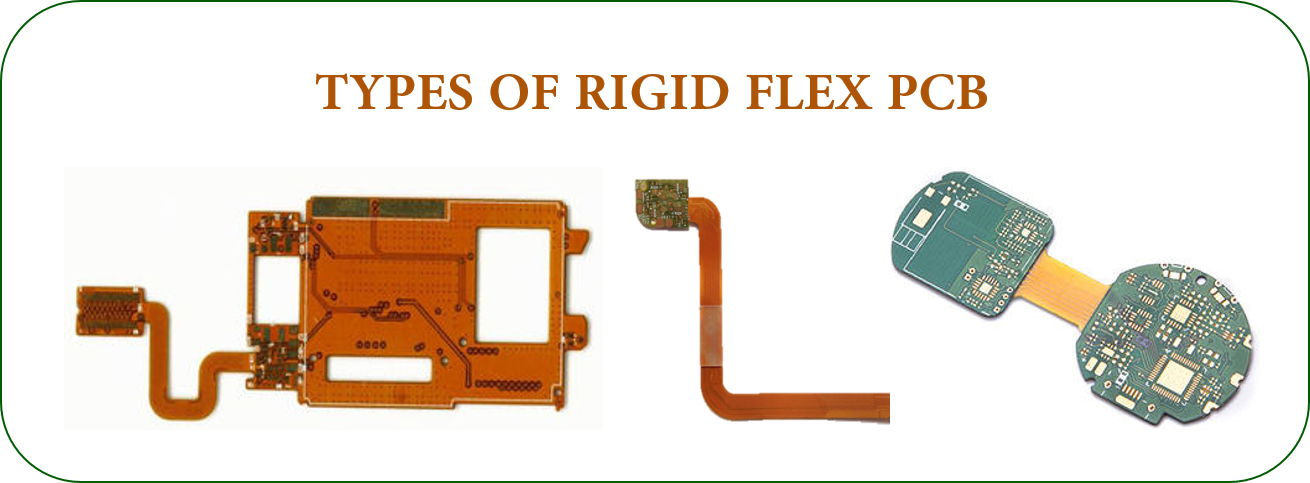
-
4 Layer Rigid Flex PCB
A four layer combination rigid flex circuit has four conductive copper layers. Typically, a four layer has two flexible layers and two rigid layers.
-
6 Layer Rigid Flex PCB
A 6 layer combination rigid flex circuit has six conductive copper layers. The two most common design types are as follows:
- 6 Layer Rigid Flex – 2 flex layers and 4 rigid layers
- 6 Layer Rigid Flex – 4 flex layers and 2 rigid layers
-
8 Layer Rigid Flex PCB
Rigid flex circuits combine the best of both rigid boards and flex circuits integrated together into one circuit. The two in one circuit is interconnected through plated thru holes. Rigid flex circuits provide higher component density and better quality control. Designs are rigid where extra support is needed and flexible around corners and areas requiring extra space.
RIGID FLEX PCB APPLICATIONS

In consumer products, Rigid Flex doesn't just maximize space and weight but greatly improves reliability, eliminating many needs for solder joints and delicate, fragile wiring that are prone to connection issues. These are just some examples, but Rigid Flex PCBs can be used to benefit nearly all advanced electrical applications including testing equipment, tools and automobiles.
RIGID FLEX PCB Manufacturing
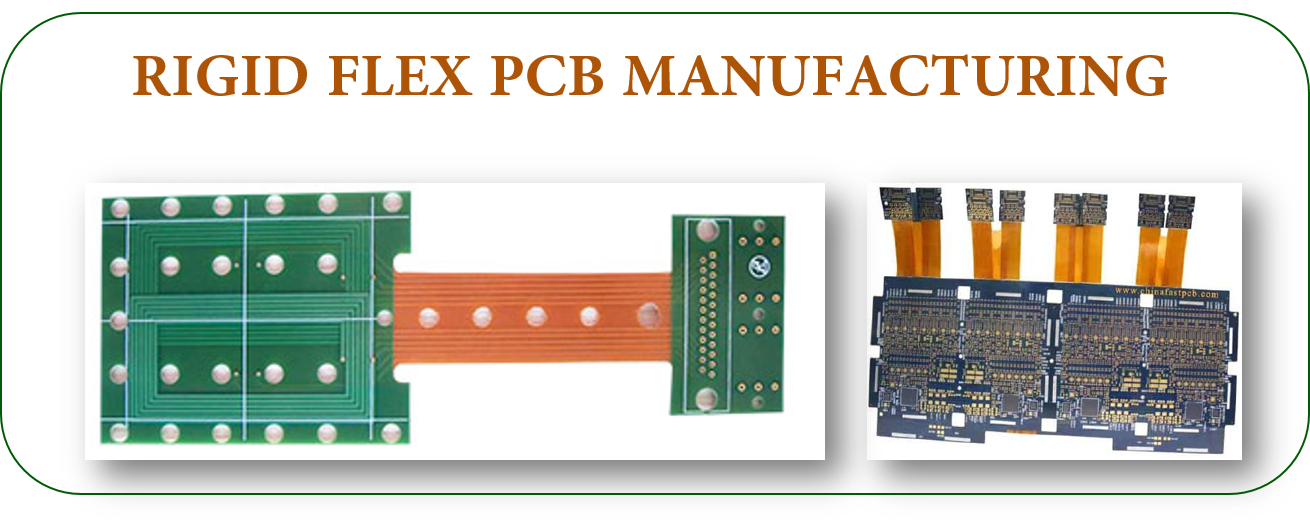
Because Rigid flex PCB is the combination of flexible PCB and rigid PCB, the production of Rigid-flex PCB should have both FPC production equipment and Rigid PCB production equipment.
Firstly, the electronic engineer draws the circuit and outline of the flexible circuit board according to the requirement, and then sends it to the factory which can produce the flexible and rigid PCB. After the CAM engineer processes and plans the relevant documents, then arranges the FPC and PCB production lines needed for FPC production line to produce PCB. After the two kinds of flexible and rigid PCB are produced, the FPC and PCB are passed through according to the planning requirements of the electronic engineer. After seamless pressing and a series of details, the rigid flex PCB are finally made.
PCB is experienced in producing custom Rigid-Flex PCB, welcome your inquiry. Please check our Rigid Flex PCB manufacturing capabilities below.
|
Item |
Manufacturing Capability |
|
PCB Layers |
1 - 12layers |
|
Laminate |
Flexible part: DuPont PI, Shengyi PI |
|
Rigid part: PI/FR4 |
|
|
Maximum PCB Size(Length x Width) |
406*610mm |
|
Board Thickness |
≤3.2mm |
|
Finished board thickness tolerance |
±2mil(±0.04m) |
|
Copper Thickness |
0.3oz - 1.0oz or higher |
|
Min Tracing/Spacing |
2.5mil/2.5mil |
|
Min. Annular Ring |
4mil |
|
Min. Drilling Hole Diameter |
8mil(0.2mm) |
|
Min. hole size |
8mil(0.2mm) |
|
Min. finished via diameter |
6mil(0.15mm) |
|
Tolerance of dimension |
3mil(0.076 mm) |
|
Solder Mask Color |
Green, White, Blue, Black, Red, Yellow |
|
Silkscreen Color |
White, Black, Yellow |
|
Surface Finish |
OSP |
|
HASL(Hot Air Solder Leveling) |
|
|
HASL Lead-Free |
|
|
Flash Gold |
|
|
ENIG (Electroless Nickle/Immersion Gold) |
|
|
Immersion Tin |
|
|
Immersion Silver |
|
|
Special technologies |
Impedance Control+/-10% |
|
Gold fingers |
|
|
Stiffener (PI/FR4) |
|
|
Peelable solder mask |
RIGID FLEX PCB FABRICATION PROCESS
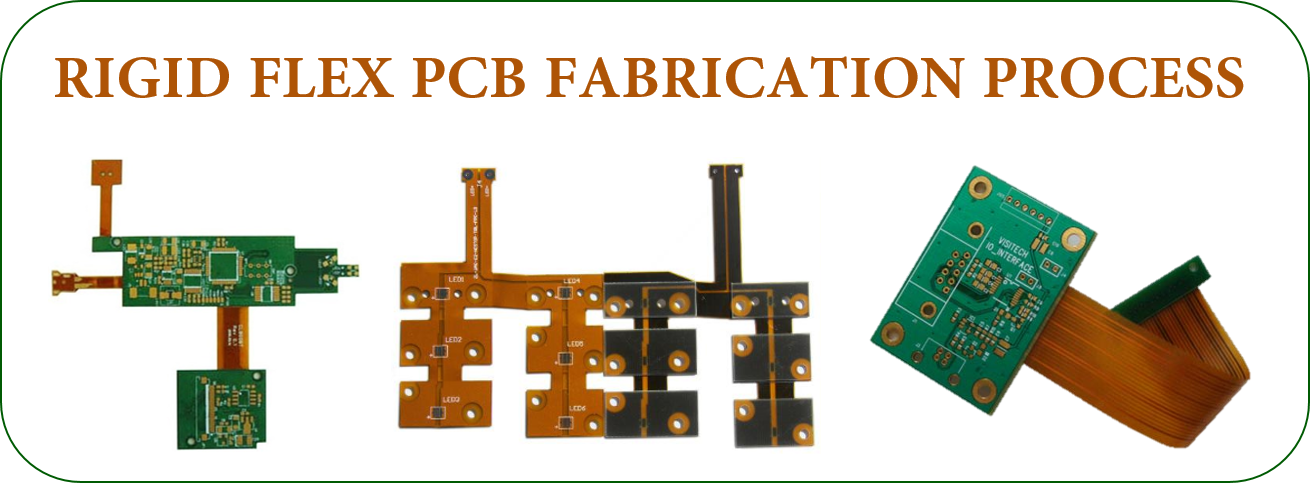
- Material selection
- Control of Production Process and Key Parts
- Production process
- Graphic Transfer of Inner Monolithic
- Multilayer Location of Flexible Materials
- Lamination
- drill hole
- De-drilling contamination and protrusion
- Electroless Copper Plating and Copper Plating
- Surface Weldability Protection Layer and Weldability Protection Layer
- Contour processing
A very important link is that the rigid flex PCB is very difficult and has many details. Before shipment, it is generally necessary to carry out a full inspection, because of its high value, so as to avoid the loss of related interests caused by both suppliers and demanders.
BENEFITS OF RIGID FLEX PCB

- Space requirements can be minimized by applying 3D
- By removing the need for connectors and cables between the individual rigid parts the board size and overall system weight can be reduced.
- By maximizing space, there is often a lower count in parts.
- Less solder joints assure higher connection reliability.
- Handling during assembly is easier in comparison with flexible boards.
- Simplified PCB Assembly processes.
- Integrated ZIF contacts provide simple modular interfaces to the system environment.
- Test conditions are simplified. A complete test prior to installation becomes possible.
- Logistical and assembly costs are significantly reduced with Rigid Flex boards.
- It is possible to increase the complexity of mechanical designs, which also improves the degree of freedom for optimized housing solutions.
RIGID FLEX PCB FABRICATION MATERIALS

- Conductors – Copper is the most widely used conductor and comes in various thicknesses to meet each customer`s requirements. Conductor options include:
- Rolled annealed (RA) copper
- Electro deposited (ED) copper
- Adhesives – Adhesive selection depends on customer needs and conductor thickness. Common adhesives include:
- Epoxy
- Acrylic
- Pre preg
- Pressure Sensitive Adhesive(PSA)
- Adhesiveless base material
- Insulators – Flexible substrate (base) and cover lay materials are available in a variety of thicknesses. Common insulators include:
- FR 4
- Polyimide
- Polyester, Polyethylene Naphthalate (PEN), and Polyethylene Terephthalate
- (PET)
- Solder mask
- Flexible solder mask
- Photo image able cover lay (PIC)
- Finishes – The final finish depends on each customer`s assembly requirements and the application of the finished product. Common finishes include:
- Solder (Tin/Lead or RoHS compliant)
- Tin
- Immersion nickel/gold
- Hard nickel/gold
- Wire bondable gold
- Organic: Entek or Organic Solderability Preservative (OSP)
- Silver
- Carbon
As the Rigid flex circuit market continues to expand, there have been many advances in technology including:
- Air Gap – Through the process of selective bonding, increased flexibility is achieved by [unbonding" layers so they are allowed to flex freely. At JHY PCB, we are proud to be a leading designer of this air gap technology allowing your designs more flexibility.
- Component Assembly – JHY PCB offers through hole and surface mount capabilities, as well as in circuit testing, conformal coating and electrostatic protective packaging.
- Controlled Impedance – With increasing signal switching speeds, engineers need to understand and control the impedance of traces. With short signal transition times and high clock rates of modern digital circuitry, traces need to be considered transmission lines instead of simple interconnections. With today`s higher speed requirements, controlled impedance traces are designed to minimize electrical reflections and ensure an error free transition between the track and interconnections. Controlled impedance, if perfectly optimized, allows control of the physical dimensions and material of the cable. Controlled impedance signal transmission requires flexible circuit materials to be uniform in both thickness and electrical properties. It is necessary that the circuit manufacturer accurately etch the copper foil to optimize impedance.
- Panelization – Multiple circuits are partially die cut with break out tabs to allow them to remain in the panel for component assembly during the [pick & place" and wave soldering processes. Once the panel of rigid flex circuit boards is assembled, simply clip them out by cutting the breakout tabs and they are ready for assembly into your final product.
- Pressure Sensitive Adhesives (PSAs)– PSAs with a release liner are used in applications where a portion(s) of the circuit needs to be secured to a specific location within the final product. During assembly, the release liner is peeled away and the exposed adhesive allows the assembler to press the circuit into place and keep it there.
- Shielding – Shielding is applied when an application requires limits in electromagnetic and/or electrostatic interference. Protective shielding can be patterned or solid. Either way, it reduces noise and controls impedance of signal lines. Repeatability is ensured through etching.
RIGID FLEX PCB DESIGN GUIDE
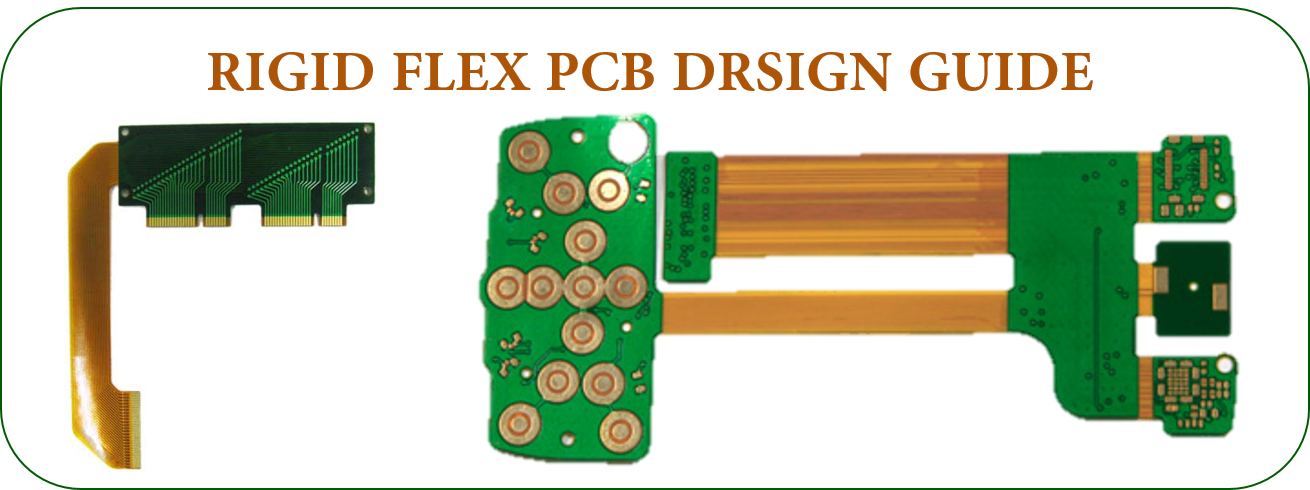
Different challenges offset the versatility and flexibility that allow you to build three dimensional designs and products. Traditional rigid flex PCB designs allowed you to mount components, connectors, and the chassis for your product to the physically stronger rigid part of the assembly. Again, in terms of traditional designs, the flexible circuit only served as an interconnect while lowering the mass and improving the resistance to vibration.
New product designs coupled with improved flex circuit technologies have introduced new design rules for rigid flex PCBs. Your design team now has the freedom to place components on the flexible circuit area. Combining this freedom with a multilayer approach to rigid flex design allows you and your team to build more circuitry into the design. However, gaining this freedom adds a few challenges in terms of routing and holes.
Flexible circuits always have bend lines that affect routing. Because of the potential for material stress, you cannot place components or vias close to the bend line.
And even when components are properly located, bending flex circuits places repeated mechanical stresses on surface mount pads and through holes. Your team can reduce those stresses by using through hole plating and by bolstering pad support with additional coverlay to anchor the pads.
As you design your trace routing, follow practices that reduce stress on your circuits. Use hatched polygons to maintain flexibility when carrying a power or ground plane on your flex circuit. You should use curved traces rather than 90° or 45° angles and use teardrop patterns to change trace widths.
These practices decrease stress points and weak spots. Another best practice distributes stress across traces by staggering the top and bottom traces for double sided flex circuits. Offsetting the traces prevents the traces from laying over each other in the same direction and strengthens the PCB.
You should also route traces perpendicular to the bend line to reduce stress. When moving from rigid to flex and back to rigid, the number of layers from one medium to the other may differ. You can use trace routing to add stiffness to the flex circuit by offsetting the routing for adjacent layers.
Electromechanical Factors Influence Design
When you design rigid flex PCBs, think in terms of electromechanical factors that affect both the flex circuit and the rigid board. As you build your design, focus on the ratio of bend radius to thickness. With flex circuits, tight bends or an increased thickness at the bend area increase the chances for failure. Fabricators recommend keeping the bend radius at a minimum of ten times the thickness of the flex circuit material and building a [paper doll" of the circuit to determine where bends occur.
You should avoid stretching the flex circuit along its outer bend or compressing it along the inner bend. Increasing the bend angle beyond 90° increases stretching at one point and compression at another point on the flex circuit.
Another key issue in rigid flex reliability is the thickness and type of conductor found in the bend region. You can decrease thickness and mechanical stress by reducing the amount of plating on the conductors and using pads only plating. The use of heavy copper, gold, or nickel plating decreases flexibility at the bend and allows mechanical stress and fracturing to occur.
Rigid flex PCB stack up
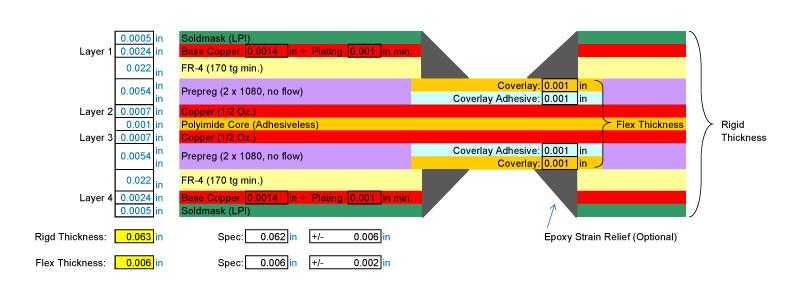
Rigid Flex PCB assembly
If you have assembly requirements for rigid flexible PCB, please refer to our PCB Assembly Service description.
YOU MAY ASK:
What is HDI PCB ?
HDI PCB is defined as a PCB with a higher wiring density per unit area than conventional PCB. They have finer lines and spaces, smaller vias and capture pads and higher connection pad density than employed in conventional PCB technology.
What is Metal Core PCB ?
MCPCB, Metal Core PCB, thermal PCB. Metal core pcb is abbreviated as MCPCB, it is made of thermal insulating layer, metal plate and metal copper foil, which has special magnetic conductivity, excellent heat dissipation, high mechanical strength and good processing performance.
What is MCPCB?
A Metal Core Printed Circuit Board (MCPCB) is a type of printed circuit board that contains a base metal material. The core is designed to redirect heat away from components which produce a substantial amount of heat.
Helpful Resources
- What is a Rigid Flex PCB?
- Rigid Flex PCB Design Guidelines
- Analysis of Manufacturing Process of Rigid Flexible PCB
- Analysis of Rigid Flexible PCB Manufacturing Process
- Rigid Flex PCB Manufacturing Capability
Rigid Flex PCB
Rigid Flex PCB,Flexible Printed Circuit Board,Polyimide PCB,FPC PCB
JingHongYi PCB (HK) Co., Limited , https://www.pcbjhy.com